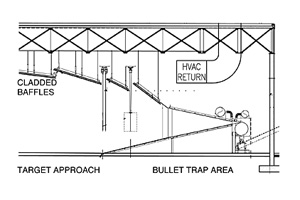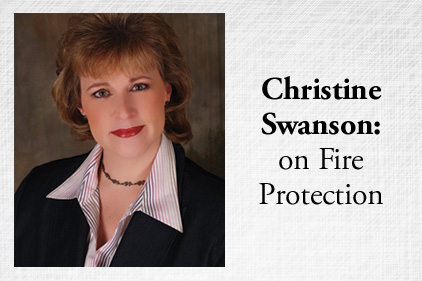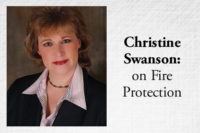
|
|
This indoor range partial elevation notes advancing shooter approach, angle of cladded ceiling baffles, bullet trap configuration and HVAC flow. Photo courtesy of Christine Swanson. |
Indoor shooting ranges might make you think about the smell of gunpowder or the sounds of gunfire.
In terms of fire protection, when considering life safety measures for a shooting range, my first thoughts are: How do I sprinkler it? What are the fire hazards? Who are the customers and what are their shooting skills?
If you have an indoor range with an advancing shooter, however, the safety of the shooter depends on ricochet hazards downrange. As small as sprinkler heads may be, providing sprinklers downrange poses additional exposed surfaces for bullet ricochet.
Zooming out, the types of ranges and skill sets of shooters make an impact on occupant safety. The use of the range should be limited to the skill level of shooter. Remotely located, outdoor ranges are better suited to beginning shooters and those starting to train on new weapons.
An indoor range is one that can be contained and ventilated. It can have a secured perimeter within building walls and lead contamination can be minimized with abatement and cleaning, as well as the use of bullet traps to reclaim projectiles. However, there still are ricochet hazards.
On the flip side, an outdoor range generally is uncontained and has a secured perimeter with a fence and is usually in a remote location. Outdoor ranges involve environmental concerns, generally having to do with lead contamination and reclaimed projectiles in bullet traps. Ricochet hazards for an advancing shooter are limited to range surface materials and/or the natural environment.
How do we observe life safety measures for indoor ranges with advancing shooters? Shooting ranges are intrinsically more hazardous than a common office building. However, even with live fire as part of everyday activities, there are steps to take in the interest of occupant safety.
Location, location, location still holds true. The range area should be on the building’s ground level if at all possible. Ground-level range location supports easier and shorter egress for occupants as well as access for first responders and exterior fire attack. With respect to ease of egress, several means should be provided. For advancing shooters, provide several down-range exterior exits. For multiple, adjacent ranges, personnel transfer doors should be located at the initial firing point (top of the range).
No storage: To minimize fire threats within the facility do not allow storage of any kind within the range area. A common practice to move past this strong statement is to separate all other occupancies from the range area with a fire barrier.
Install sprinklers: Yes, I couldn’t get away from this. It still is strongly recommended to provide automatic, wet-pipe sprinklers in all areas within the facility, except downrange. With wet-pipe sprinkler systems, the facility must be heated. If the facility is considered a high-value property, manual sprinklers are recommended for downrange areas with a control valve located in the range master’s office. In more austere facilities, life safety becomes more of a priority than property protection. Therefore, when the facility is unoccupied or closed for the day, sprinklers become less of a protection and more of a liability due to leaks from freezing or projectile damage.
Minimize ricochet: Conceal all building mechanical ducts, piping and metallic conduit behind ceiling baffles and in wall channels. Clad all exposed ricochet hazards with a less-rigid material such as fire retardant-treated plywood or ballistic rubber panels. Clad walls, structure and steel-ceiling baffles with fire retardant-treated plywood, if allowed by the authority having jurisdiction. This is a less expensive choice for high-use ranges where regular cladding changes are necessary. Ballistic rubber cladding panels capture bullets, but tend to be more expensive and will likely become saturated faster than plywood, requiring more frequent cladding replacement.
If sprinklers in the downrange area are unavoidable, the range width can be limited and sidewall sprinklers may be installed in the range side walls. This approach involves the sidewall sprinklers being tucked just behind the baffles while observing sprinkler spacing limitations.
Several documents are available that provide guidance on small-arms indoor ranges. Specific requirements published include overall range layout, air quality, fire protection and lead contamination.
Of particular note is the U.S. Air Force’s “Engineering Technical Letter, ETL 11-18, Small Arms Range Design and Construction.” Also of use is a paper entitled “Design Criteria for Shooting Ranges” written by Jacksonville, Fla.-based Clark Vargas, P.E.
Generally, keeping it simple will go a long way in providing life safety in shooting ranges.


